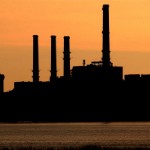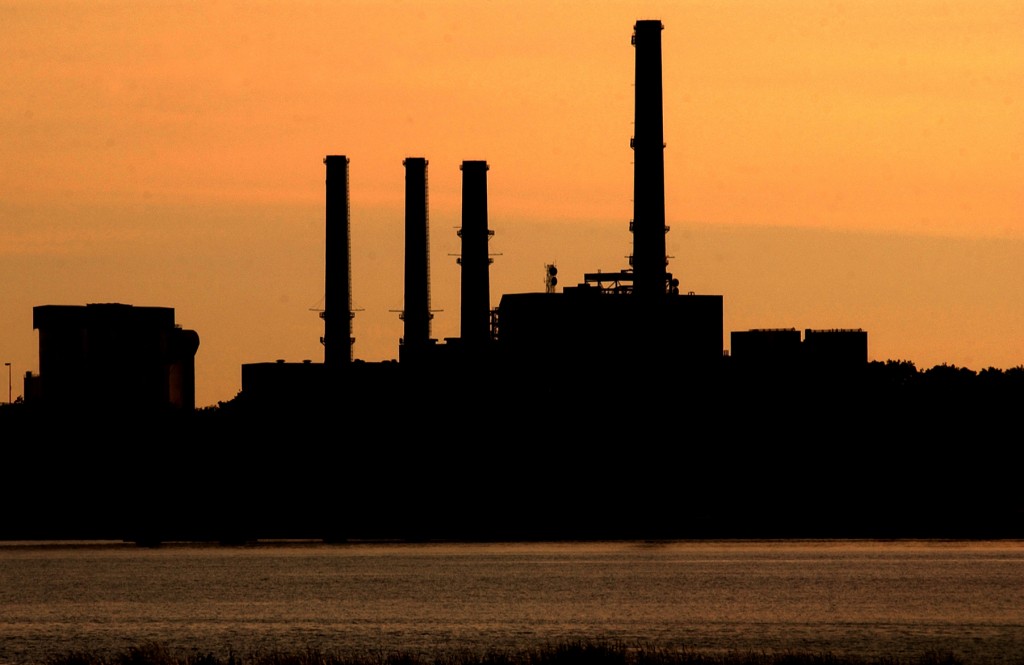New England Power Company at Brayton Point, viewed from Swansea, Somerset and Fall River.
Photo credit Tom Maguire / The Sun Chronicle of Attleboro
By Doug Struck
New England Center For Investigative Reporting
School teacher Renee Matos Driscoll remembers as a little girl riding in a car with her sister as they passed the Brayton Point power plant in Somerset, Ma.
“I pointed to a smokestack and said, ‘Look, it’s making clouds.’ She said, ‘No, that’s pollution.’” Now 36, and expecting her first child, Driscoll knows what pours out of the fourstacks of the plant in her hometown, and it worries her. She has become active in the Somerset Coalition for Clean Air.
“It affects the air and the atmosphere. You can go into how it’s affecting weather patterns, and glaciers are melting, and the CO2 in the earth is being released. It’s just a scary cycle,” she said. “I just feel we shouldn’t have to sacrifice the health of our children for the health of our economy.”
Brayton Point and two other electricity-generating plants in Massachusetts produce nearly half of the total greenhouse gases emitted by all large polluters throughout the state, according to data compiled by the Environmental Protection Agency.
The power plants— Mystic Station in Everett and Fore River in Weymouth that burn natural gas, and the coal-burning Brayton Point plant in Somerset– pumped into the air nearly 8.7 million metric tons of carbon dioxide and other greenhouse gases in 2011. The total pollution from all large facilities in the state was 18.5 million metric tons that year, the most recent data available, according to the EPA.
The data, compiled in preparation for the court-ordered regulation by the EPA of greenhouse gases, highlights the dominance of fossil-fuel power plants in the production of the pollutants that scientists say are quickly heating the planet.
Indeed, all of the top ten large greenhouse gas polluters in Massachusetts are from power plants that burn coal, gas or oil, according to the EPA data. (See chart.)
“Science is very, very clear about what we need to do. We need to get off these high carbon fuels,” said Seth Kaplan, a senior attorney at the Conservation Law Foundation in Boston. “We need to use electricity more efficiently, and we need to get more and more and more of our power from truly zero emissions sources, like wind and solar.”
The portrait from the EPA data of polluters does not include cars, other transportation or small emitters. Only the 92 large, stationary “point source” carbon dioxide emitters in Massachusetts are included on the list. According to the agency, the large point-source emitters contribute more than half of the pollutants that enter the atmosphere. Those emissions have sent carbon dioxide levels soaring to a level not seen on earth for 2 million years.
The large share of the total pollutants from a few plants suggests that major reductions in greenhouse gases could be made by addressing relatively few facilities, according to Michael Ash, a professor of economics and public policy at the University of Massachusetts Amherst. He and colleagues published a 2013 study based on the same EPA data that traced ownership of polluting facilities.
“If you see a small number of inefficient plants at the top of the list, that may be a place to make cheap improvements,” he said. Their study showed Exelon Power, which owns Mystic Station and Fore River, is the 34th largest polluter among large facilities in the country through its 43 fossil fuel power facilities. Dominion Resources, which owns Brayton Point, is listed as 11th, with 47 listed power stations.
That the Mystic Station and Fore River plants were ranked number one and number three in Massachusetts came as a surprise to some, including a spokesman for Exelon.
The plants use “some of the cleanest and most environmentally friendly options for generating electricity in Massachusetts,” said company spokesman Kevin Thornton. The plants mostly use natural gas—although one of the three units at Mystic sometimes runs on oil—to produce about half of the electricity needed in the Boston area. And the plants are “combined cycle,” an efficient design that generates electricity with gas and then uses the heat byproduct to make more electricity.
Their position in the top of the pollution list “is a function of how big they are and that they run all the time,” said Thornton.
“Mystic Plant being at the top of the list is very good,” said Stephen Connors, head of an electric regional energy analysis group at the MIT Energy Initiative. As the more modern gas-burning plant replaces coal-burning electricity production, the level of greenhouse gas emissions are cut, he said.
Those gas plants are likely to remain the top polluters because there is no ready substitute to provide all the needed power, especially as New England weans itself from aging nuclear plants, he added. Connors said the immediate goal should be to satisfy any new growth in electrical demand with alternative fuels, such as wind and solar, as those alternatives grow.
“We are going to use natural gas, but we only want it to displace the higher carbon plants—coal units or older natural gas units. We want to make sure the region’s increased electrical demand is met by ‘no carbon’ not ‘low carbon.’” Connors said. That also requires embracing energy efficiencies to reduce growth in demand, he said.
“We are dependent on natural gas for the next 10 or 20 years,” he added. “We need to use that time to go from low to no carbon. And the question is, how do you go about that? By 2030, you would want to see significant learning and investment.”
Brayton Point, was listed as the state’s second-largest greenhouse gas polluter in 2011. Environmental and civic activists have mounted a very visible public campaign to close the plant because of its dirty emissions.
“Every day Brayton Point continues to operate poses a threat to health in the area,” said Sylvia Broude, head of the Toxics Action Center, which has helped organize the campaign. The health threats are both from pollutants that settle on the area and those that go into the atmosphere, she said.
“Global warming is being painted accurately as a threat to human health and survival on the planet,” she said. “Everyone agrees with the goals of moving away from fossil fuels.”
Dan Genest, a spokesman for Dominion Power, which is in the process of selling Brayton Point, acknowledged “there isn’t much that can be done with coal power” in terms of reducing greenhouse gas emissions. “The technology isn’t there.”
Dominion spent $1.1 billion for emissions controls at the plant, he said. The expected sale price for the plant has not been disclosed but is expected to be far less than that expenditure. The company is closing Salem Point, which it also owns, and other coal plants, and converting other coal plants to gas and biomass, he said.
“All of those things make a difference company-wide,” Genest said. “Our carbon intensity for a utility of our size is pretty low.”
The ranking in the EPA data spotlights how rapidly coal-fired plants, usually the dirtiest of power producers, are being shuttered in the state, which was once powered by what was dubbed the “Filthy Five” coal-and-oil power plants. Those five are dwindling. The Mystic plant switched from coal in 1968 and phased out other oil-burning units in favor of natural gas by 2003, according to the company spokesman; Mount Tom power plant in Holyoke had cut back operating hours last year by two-thirds of its 2009 level; Brayton Point in Somerset was operating less than half-time and is being sold; Salem Harbor last year was operating at 22 percent of the previous level; and Canal Station in Sandwich was working less than 10 percent of its 2009 operating hours, according to data filed with the Regional Greenhouse Gas Initiative.
With natural gas supplies brimming from the boom in the controversial process of fracking, gas is cheap, making coal plants uneconomical to run. The result, along with tighter pollution controls, has caused a sea-change in our nation’s power generation, long dependent on the abundant U.S. reserves of coal. Natural gas still emits carbon dioxide and other pollutants, but at roughly half the rate of coal-burning power plants.
Coal plants “are a dying breed for a whole bunch of reasons,” said Daniel Sosland, executive director of the non-profit group Environment Northeast. “They cannot compete with natural gas, and renewables are becoming more cost-competitive.”
Coal was used to produce 28 percent of the northeast region’s electricity in 2001; last year that had fallen to less than 10 percent, he said.
“Until very, very recently Number One would have been Brayton and Number Two would have been Salem,” on the list of top greenhouse gas polluters, said Kaplan, of the Conservation Law Foundation in Boston. “Coal plants are running much, much less.”
But Kaplan sees those improvements as only partial progress. “Grinding up rocks and burning them to make electricity is crazy,” he said. “People are using computers and Ipads and Iphones that are charged by burning rocks.
“As a first step to getting off of that, natural gas made a lot of sense,” he said. “It’s essential, in the short term, in retiring our coal plants, and getting our emissions down to half of what it used to be. But it won’t go below that if we continue to use natural gas. That reduction is not big enough. We need to continue the journey.”
The New England Center for Investigative Reporting www.necir-bu.org is a nonprofit investigative reporting newsroom based at Boston University.
– See more at: http://necir-bu.org/investigations/fossil-fuel-power-plants-among-largest-greenhouse-gas-polluters-in-massachusetts/#sthash.lzsJVKFW.dpuf


